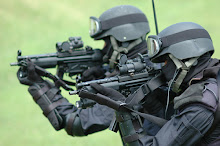
Someday, the secrets of fireflies or glowing sea plankton could save an American soldier in battle, a Navy SEAL on a dive or a military pilot landing after a mission. That's the hope behind a growing field of military-sponsored research into bioluminescence, a phenomenon that's under the microscope in laboratories around the country.
For university scientists who specialize in bioluminescence, an organism's ability to illuminate with its own body chemistry, military research grants are offering a chance to break ground.
A possible military use of bioluminescence would be creating biodegradable landing zone markers that helicopters can spot even as wind from their rotors kicks up dirt.
The military could also develop bioluminescent "friend vs. foe" identification markers and security systems, and methods to track weapons and supplies on the battlefield.
First described around 500 B.C. by the Greek philosopher Anaximenes, bioluminescence is familiar by its sight - if not its name - to children catching fireflies and to divers entranced by lanternfish and other sea life.
It's also the factor behind the renowned Bio Bay in Vieques, Puerto Rico, where floating microorganisms called dinoflagellates leave neon-blue trails when disturbed.
The phenomenon is noteworthy because it creates light without heat, said Bruce Branchini, a chemistry professor at Connecticut College in New London.
For the military, that could mean using bioluminescence to mark objects or locations wouldn't make them vulnerable to an enemy with heat-seeking technology.
Branchini, who recently received a $225,000 grant for his work studying lightning bugs, is examining ways to use their proteins to mutate the greenish-yellow glow to create what's called "far red."
That light, just short of infrared, is just off the spectrum of human vision and is the same light produced in the signals of television remote controls.
"What they're going to do with it, I don't know," Branchini said. "I don't have secret clearance, I don't go to secret meetings. They'll work on the practical applications, but what interests me the most is the research portion."
Hugh De Long, deputy director of math, information and life sciences at the Air Force Office of Scientific Research, said it has given about $500,000 in grants yearly for bioluminescence studies since 2002 or 2003.
The Office of Naval Research and the National Science Foundation also give grants for bioluminescence work, sometimes several million dollars at a time. They hope for long-term benefits for the military, health researchers and other government entities by encouraging the basic biological research with financial incentives.
De Long said although government researchers also work on bioluminescence, tapping the knowledge of academics throughout the United States is key.
"It's much more beneficial and efficient for the military to go out to the university community and say, 'Hey, look, this is an area that will tie in with some of the stuff we're doing, and we want to fund that,'" De Long said.
(www.military.com)
For university scientists who specialize in bioluminescence, an organism's ability to illuminate with its own body chemistry, military research grants are offering a chance to break ground.
A possible military use of bioluminescence would be creating biodegradable landing zone markers that helicopters can spot even as wind from their rotors kicks up dirt.
The military could also develop bioluminescent "friend vs. foe" identification markers and security systems, and methods to track weapons and supplies on the battlefield.
First described around 500 B.C. by the Greek philosopher Anaximenes, bioluminescence is familiar by its sight - if not its name - to children catching fireflies and to divers entranced by lanternfish and other sea life.
It's also the factor behind the renowned Bio Bay in Vieques, Puerto Rico, where floating microorganisms called dinoflagellates leave neon-blue trails when disturbed.
The phenomenon is noteworthy because it creates light without heat, said Bruce Branchini, a chemistry professor at Connecticut College in New London.
For the military, that could mean using bioluminescence to mark objects or locations wouldn't make them vulnerable to an enemy with heat-seeking technology.
Branchini, who recently received a $225,000 grant for his work studying lightning bugs, is examining ways to use their proteins to mutate the greenish-yellow glow to create what's called "far red."
That light, just short of infrared, is just off the spectrum of human vision and is the same light produced in the signals of television remote controls.
"What they're going to do with it, I don't know," Branchini said. "I don't have secret clearance, I don't go to secret meetings. They'll work on the practical applications, but what interests me the most is the research portion."
Hugh De Long, deputy director of math, information and life sciences at the Air Force Office of Scientific Research, said it has given about $500,000 in grants yearly for bioluminescence studies since 2002 or 2003.
The Office of Naval Research and the National Science Foundation also give grants for bioluminescence work, sometimes several million dollars at a time. They hope for long-term benefits for the military, health researchers and other government entities by encouraging the basic biological research with financial incentives.
De Long said although government researchers also work on bioluminescence, tapping the knowledge of academics throughout the United States is key.
"It's much more beneficial and efficient for the military to go out to the university community and say, 'Hey, look, this is an area that will tie in with some of the stuff we're doing, and we want to fund that,'" De Long said.
(www.military.com)

No comments:
Post a Comment